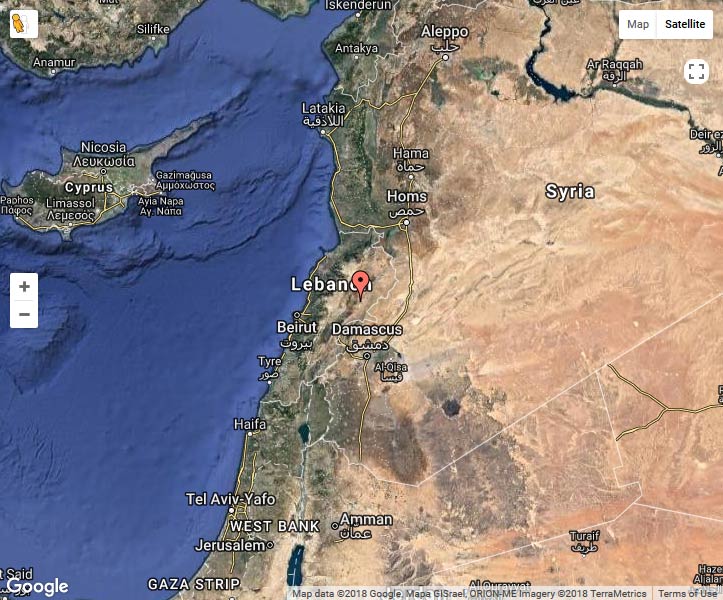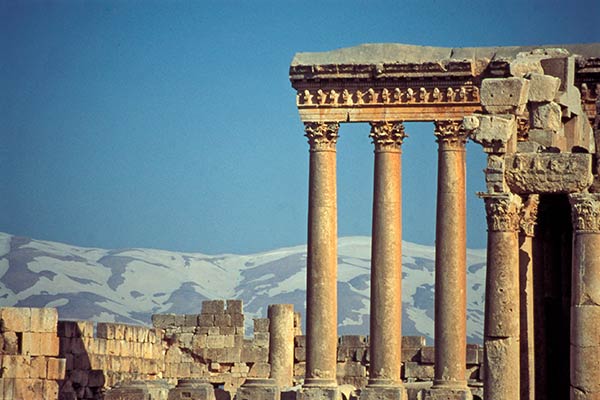
Roman structures at pre-Roman site of Baalbek (Enlarge)
Approximately 86 kilometers northeast of the city of Beirut in eastern Lebanon stands the temple complex of Baalbek. Situated atop a high point in the fertile Bekaa valley, the ruins are one of the most extraordinary and enigmatic holy places of ancient times. Long before the Romans conquered the site and built their enormous temple of Jupiter, long even before the Phoenicians constructed a temple to the god Baal, there stood at Baalbek the largest stone block construction found in the entire world.
The origin of the name Baalbek is not precisely known and there is some difference of opinion among scholars. The Phoenician term Baal (as the Hebrew term Adon) simply means ‘lord’ or ‘god’ and was the title given to the Semitic sky-deity worshipped throughout the archaic Middle East. The word Baalbek may mean 'God of the Bekaa valley' (the local area) or ‘God of the Town’, depending on different interpretations of the word. Ancient legends assert that Baalbek was the birthplace of Baal. Some scholars have suggested that Baal (the Assyrian Hadad) was only one of a triad of Phoenician deities that were once venerated at this site - the others being his son Aliyan, who presided over well-springs and fecundity, and his daughter Anat (Assyrian Atargatis).
In the Seleucid (323-64 BC) and Roman (64 BC-312 AD) periods, the town became known as Heliopolis, the ‘City of the Sun.' The sky/sun god Jupiter became the central deity of the shrine during this time. Arguably the most important deity of the Romans and taking over the role of Zeus in the Greek pantheon, Jupiter was probably chosen to replace the much earlier worship of the Phonecian god Baal who had many characteristics in common with the Greek Zeus. Many Roman emperors were of Syrian birth, so it would not have been unusual for them to have promoted the worship of the country's indigenous deities under their adopted Roman names. Whatever the nature of the pre-Roman worship at Baalbek, its veneration of Baal created a hybrid form of the god Jupiter, generally referred to as Jupiter Heliopolitan. The Romans also assimilated the worship of the goddess Astarte with that of Aphrodite or Venus, and the god Adonis was identified with Bacchus.
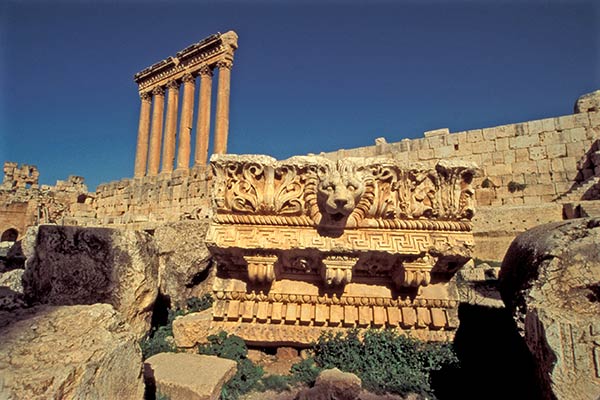
Roman structures at pre-Roman site of Baalbek (Enlarge)
The origin and development of Baalbek may be considered from two quite different paradigms of prehistory, one the conventional approach that views civilization as having only begun in middle Neolithic times and the alternative approach which suggests that developed cultures existed in what is archaeologically known as the Paleolithic period. Let us first examine the chronology of Baalbek from the conventional interpretation, following which I will discuss some amazing site anomalies that can only be explained by recourse to a far older and now lost civilization.
According to theories stated by the mainstream archaeological community, the history of Baalbek reaches back approximately 5000 years. Excavations beneath the Great Court of the Temple of Jupiter have uncovered traces of settlements dating to the Middle Bronze Age (1900-1600 BC) built on top of an older level of human habitation dating to the Early Bronze Age (2900-2300 BC). Biblical passages (I Kings, IX: 17-19) mention the name of King Solomon in connection with a place that may be ancient Baalbek (“And Solomon built Gezer and Beth-Horon, the lower, and Baalath and Tadmor in the wilderness”), but most scholars are hesitant to equate this Baalath with Baalbek and therefore deny any connection between Solomon and the ruins. Because the great stones of Baalbek are similar, though far larger, than the stones of the temple of Solomon in Jerusalem, archaic myths had arisen that Solomon erected both structures. If Solomon had really erected the site of Baalbek, however, it is astonishing that the Old Testament has mentioned nothing of the matter.
After the time of Solomon, the Phoenicians became masters of Syria and chose the site of Baalbek for a temple to their Sun-god Baal-Hadad. Little is known of Baalbek from this period. The late 11th century BC witnessed the arrival of an Assyrian army on the Mediterranean coast but because Baalbek is not mentioned alongside the names of other Phonecian cities, it has been assumed that Baalbek was an obscure religious center with no political or trading importance.
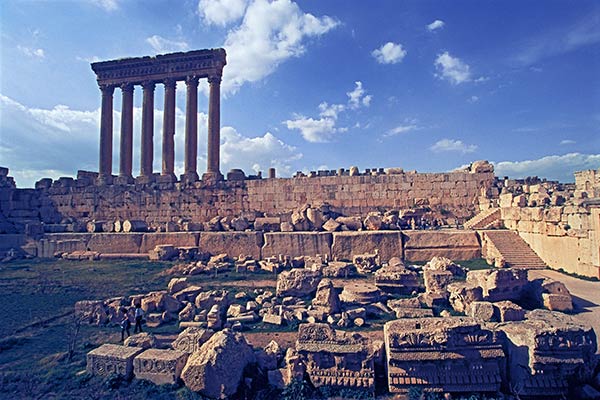
Roman structures atop massive pre-Roman stones of Baalbek (Enlarge)
The first-century AD Jewish historian Josephus tells of Alexander's march through the Beqa'a on his way to Damascus, during which he encountered the city of Baalbek. Following the death of Alexander in 323 BC, Phoenicia was ruled successively by the Ptolemaic kings of Egypt and the Seleucid kings of Syria until the arrival of the Romans. The name Heliopolis, by which Baalbek was known during Greco-Roman times, derives from Greek association with the site beginning in 331 BC. Meaning ‘City of the Sun’, the name was also used by the Ptolemies of Egypt between 323 and 198 BC, in order to express the importance this holy site held for the Egyptians. A sacred site with this same name already existed in Egypt and the new Ptolomaic rulers may have found it provident to link the ancient sky-god of Baalbek with the Egyptian god Re and the Greek Helios in order to establish closer religious and cultural ties between their newly established Ptolomaic dynasty in Egypt and the eastern Mediterranean world. In the historical writings of Ambrosius Theodosius Macrobius, a Latin grammarian who lived during the 5th century AD, the god of the holy place was called Zeus Heliopolitanus (a Greek god) and the temple was mentioned as a place of oracular divination, similar to such sites as Delphi and Dodona in Greece and the temple of Amun at Siwa in Egypt.
The golden age of Roman building at Baalbek/Heliopolis began in 15BC when Julius Caesar settled a legion there and began construction of the great Temple of Jupiter. During the next three centuries, as emperors succeeded one another in the imperial capital of Rome, Heliopolis would be filled with the most massive religious buildings ever constructed in the far reaching Roman Empire. These monuments functioned as places of worship until Christianity was declared the official religion of the Roman Empire in 313 AD, following which the Byzantine Christian emperors and their rapacious soldiers desecrated thousands of pagan sanctuaries. At the end of the 4th century, Emperor Theodosius destroyed many significant buildings and statues, and constructed a basilica with stones from the Temple of Jupiter. This signaled the end of Roman Heliopolis. The city of the sun declined and lapsed into relative oblivion.
In the year 634, Muslim armies entered Syria and besieged Baalbek. A mosque was built within the walls of the temple compound, which was itself converted into a citadel. Over the next several centuries, the city and region of Baalbek were controlled by various Islamic dynasties including the Umayyads, Abbasids and Fatamids as well as the Seljuk and Ottoman Turks. During these years, Baalbek was ravaged by the Tartars in 1260, Tamerlane in 1401 and was also shaken by numerous powerful earthquakes.
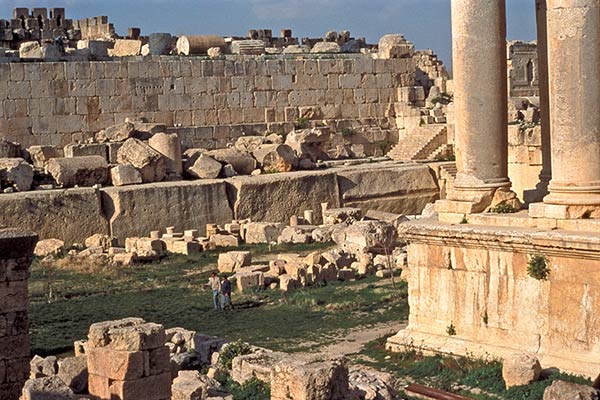
At the base of the far wall, the great stones of Baalbek (Enlarge)
In the 1700’s, European explorers began to visit the ruins and in 1898 the German emperor, William II organized the first restoration of the ancient temples. Following the lead established by the Germans, extensive archaeological excavations were carried out by the French government and later the Lebanese Department of Antiquities. While a great deal of much needed restoration work was performed by these archaeologists, the analysis of the ancient origins and use of the site was limited by the prevailing academic view of prehistory which does not recognize the possibility of sophisticated civilizations in early Neolithic or pre-Neolithic times. Particular structures at the Baalbek ruins can, however, only be explained by recourse to such extremely ancient cultures.
The ruins of Baalbek, situated on a large hill (1150 meters) with an expansive view over the adjoining plains, are bordered on two sides by the town of Baalbek and on the other sides by agricultural land belonging to local farmers. Within the sprawling complex are a profusion of temples and platforms filled with a stunning collection of fallen columns and sculptures. The primary structures at the ruins are the Great Court; the Temple of Baal/Jupiter situated upon the massive pre-Roman stone blocks known as the Trilithon; the so-called Temple of Bacchus; and the circular temple believed to be associated with the goddess Venus. Let us briefly discuss the Roman constructions first.
The Great Court, begun during the reign of Trajan (98-117), measured 135 meters by 113 meters, contained various religious buildings and altars, and was surrounded by a splendid colonnade of 128 rose granite columns. These magnificent columns, 20 meters tall and of enormous weight, are known to have been quarried in Aswan, Egypt but how they were actually transported by land and sea to Baalbek remains an engineering mystery. Today, only six columns remain standing, the rest having been destroyed by earthquakes or taken to other sites (for example, Justinian appropriated eight of them for the basilica of Hagia Sophia in Constantinople).
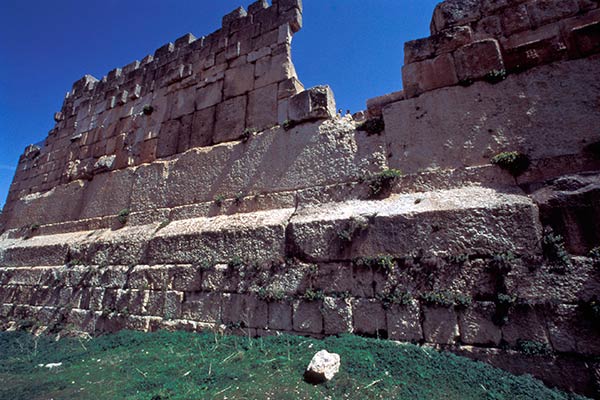
Massive foundation stones of Baalbek (Enlarge)
The Temple of Baal/Jupiter was begun during the reign of Emperor Augustus in the late first century BC and completed soon after 60 AD. The single largest religious edifice ever erected by the Romans, the immense sanctuary of Jupiter Heliopolitanus was lined by 104 massive granite columns, imported from Aswan in Egypt, and held a temple surrounded by 50 additional columns, almost 19m (62ft) high. The Temple is believed to have been consecrated to a triad of deities: Hadad (Baal/Jupiter), the god of Heaven; Atargates (Astarte/Hera), the wife of Hadad; and Mercury, their son.
As the vast temple complex expanded throughout Roman times, the so-called Temple of Bacchus was constructed in the middle of the 2nd century BC. It is called the Temple of Bacchus (the god of fertility and good cheer) mainly because a number of its sculptured reliefs have been interpreted by archaeologists as scenes from the childhood of this god (although some scholars argue this temple was dedicated to Mercury, the winged god of communication). The best-preserved Roman temple in the world, it is sixty-nine meters long by thirty-six meters wide and is surrounded by forty-two columns nineteen meters in height.
At the beginning of the 3rd century a lovely circular temple was added to the Baalbek complex. While early European visitors assumed it was a Venus temple due to its ornamentation of seashells, doves and other artistic motifs associated with the cult of this goddess, it is not known for certain which deity the shrine was actually dedicated to. During Byzantine Christian times the temple was used as a church by Greek Catholics and dedicated to the early Christian martyr Saint Barbara.
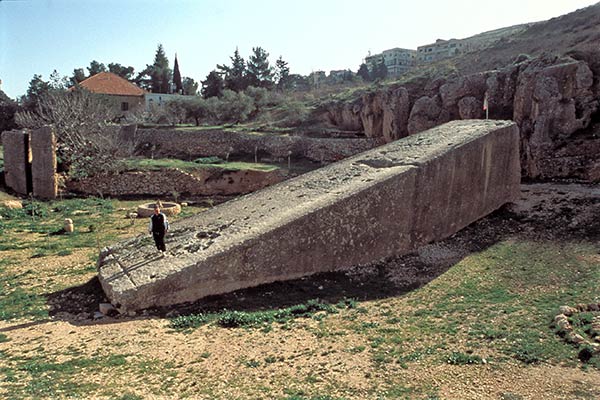
Stone of the Pregnant Woman, weighing approximately 1000 tons (Enlarge)
The great mystery of the ruins of Baalbek, and indeed one of the greatest mysteries of the ancient world, concerns the massive foundation stones beneath the Roman Temple of Jupiter. The courtyard of the Jupiter temple is situated upon a platform, called the Grand Terrace, which consists of a huge outer wall and a filling of massive stones. The lower courses of the outer wall are formed of huge, finely crafted and precisely positioned blocks. They range in size from thirty to thirty three feet in length, fourteen feet in height and ten feet in depth, and weigh approximately 450 tons each. Nine of these blocks are visible on the north side of the temple, nine on the south, and six on the west (others may exist but archaeological excavations have thus far not dug beneath all the sections of the Grand Terrace). Above the six blocks on the western side are three even larger stones, called the Trilithon, whose weight exceeds 1000 tons each. These great stones vary in size between sixty-three and sixty-five feet in length, with a height of fourteen feet six inches and a depth of twelve feet.
Three other even larger monoliths are found in a limestone quarry a quarter of a mile from the Baalbek complex. The first, called the Stone of the Pregnant Woman (Hadjar el Hibla in Arabic) or Stone of the South (Hadjar el Gouble in Arabic) is sixty-nine feet by sixteen feet by thirteen feet ten inches and weights an estimated 1000 tons. This stone lays at a raised angle with the lowest part of its base still attached to the quarry rock as though it were almost ready to be cut free and transported to its presumed location next to the other stones of the Trilithon. A second stone was discovered nearby in the 1990’s and weighs an estimated 1200 tons. A third, only recently discovered beneath the Stone of the Pregnant Woman, may exceed 1200 tons but its size and weight are estimates because its base has not yet been excavated.
Why these stones are such an enigma to contemporary scientists, both engineers and archaeologists alike, is that their method of quarrying, transportation and precision placement is beyond the technological ability of any known ancient or modern builders. Various ‘scholars’, uncomfortable with the notion that ancient cultures might have developed knowledge superior to modern science, have decided that the massive Baalbek stones were laboriously dragged from the nearby quarries to the temple site. While carved images in the temples of Egypt and Mesopotamia do indeed give evidence of this method of block transportation - using ropes, wooden rollers and thousands of laborers - the dragged blocks are known to have been only 1/10th the size and weight of the Baalbek stones and to have been moved along flat surfaces with wide movement paths. The route to the site of Baalbek, however, is up hill, over rough and winding terrain, and there is no evidence whatsoever of a flat hauling surface having been created in ancient times.

Baalbek Aerial View
Next there is the problem of how the mammoth blocks, once they were brought to the site, were lifted and precisely placed in position. It has been theorized that the stones were raised using a complex array of scaffolding, ramps and pulleys which was powered by large numbers of humans and animals working in unison. An historical example of this method has been suggested as the solution for the Baalbek enigma. The Renaissance architect Domenico Fontana, when erecting a 327-ton Egyptian obelisk in front of St Peter's Basilica in Rome, used 40 huge pulleys, which necessitated a combined force of 800 men and 140 horses. The area where this obelisk was erected, however, was a great open space that could easily accommodate all the lifting apparatus and the men and horses pulling on the ropes. No such space is available in the spatial context of how the Baalbek stones were placed. Hills slope away from where lifting apparatus would need to have been placed and no evidence has been found of a flat and structurally firm surface having been constructed (and then mysteriously removed after the lifting was done). Furthermore, not just one obelisk was erected but rather a series of giant stones were precisely put in place side-by-side. Due to the positioning of these stones, there is simply no conceivable place where a huge pulley apparatus could have been stationed.
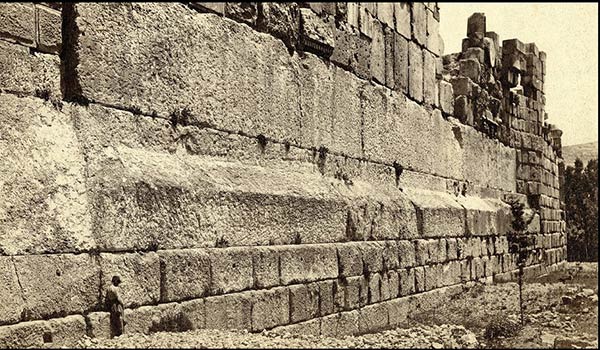
Great foundation stones at Baalbek
Archaeologists, unable to resolve the mysteries of the transportation and lifting of the great blocks, rarely have the intellectual honesty to admit their ignorance of the matter and therefore focus their attention solely on redundant measurements and discussions regarding the verifiable Roman-era temples at the site. Architects and construction engineers, however, not having any preconceived ideas of ancient history to uphold, will frankly state that there are no known lifting technologies even in current times that could raise and position the Baalbek stones given the amount of working space. The massive stones of the Grand Terrace of Baalbek are simply beyond the engineering abilities of any recognized ancient or contemporary builders.
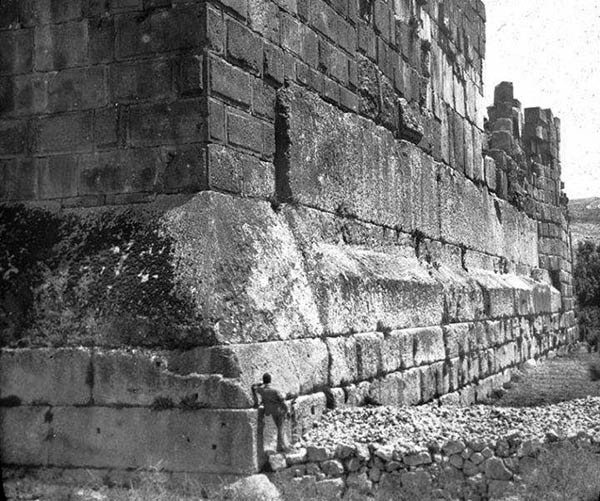
Great foundation stones at Baalbek
There are several other matters about the Baalbek stones that further confound archaeologists and conventional theories of prehistoric civilization. There are no legends or folk tales from Roman times that link the Romans with the mammoth stones. There are absolutely no records in any Roman or other literary sources concerning the construction methods or the dates and names of the benefactors, designers, architects, engineers and builders of the Grand Terrace. The megalithic stones of the Trilithon bear no structural or ornamental resemblance to any of the Roman-era constructions above them, such as the previously described Temples of Jupiter, Bacchus or Venus. The limestone rocks of the Trilithon show extensive evidence of wind and sand erosion that is absent from the Roman temples, indicating that the megalithic construction dates from a far earlier age. Finally, the great stones of Baalbek show stylistic similarities to other cyclopean stone walls at verifiably pre-Roman sites such as the Acropolis foundation in Athens, the foundations of Myceneae, Tiryns, Delphi and even megalithic constructions in the ‘new world’ such as Ollyantaytambo in Peru and Tiahuanaco in Bolivia.
 Martin Gray is a cultural anthropologist, writer and photographer specializing in the study of pilgrimage traditions and sacred sites around the world. During a 40 year period he has visited more than 2000 pilgrimage places in 165 countries. The World Pilgrimage Guide at sacredsites.com is the most comprehensive source of information on this subject.
Martin Gray is a cultural anthropologist, writer and photographer specializing in the study of pilgrimage traditions and sacred sites around the world. During a 40 year period he has visited more than 2000 pilgrimage places in 165 countries. The World Pilgrimage Guide at sacredsites.com is the most comprehensive source of information on this subject.Additional information on Baalbek at ancient-wisdom.
